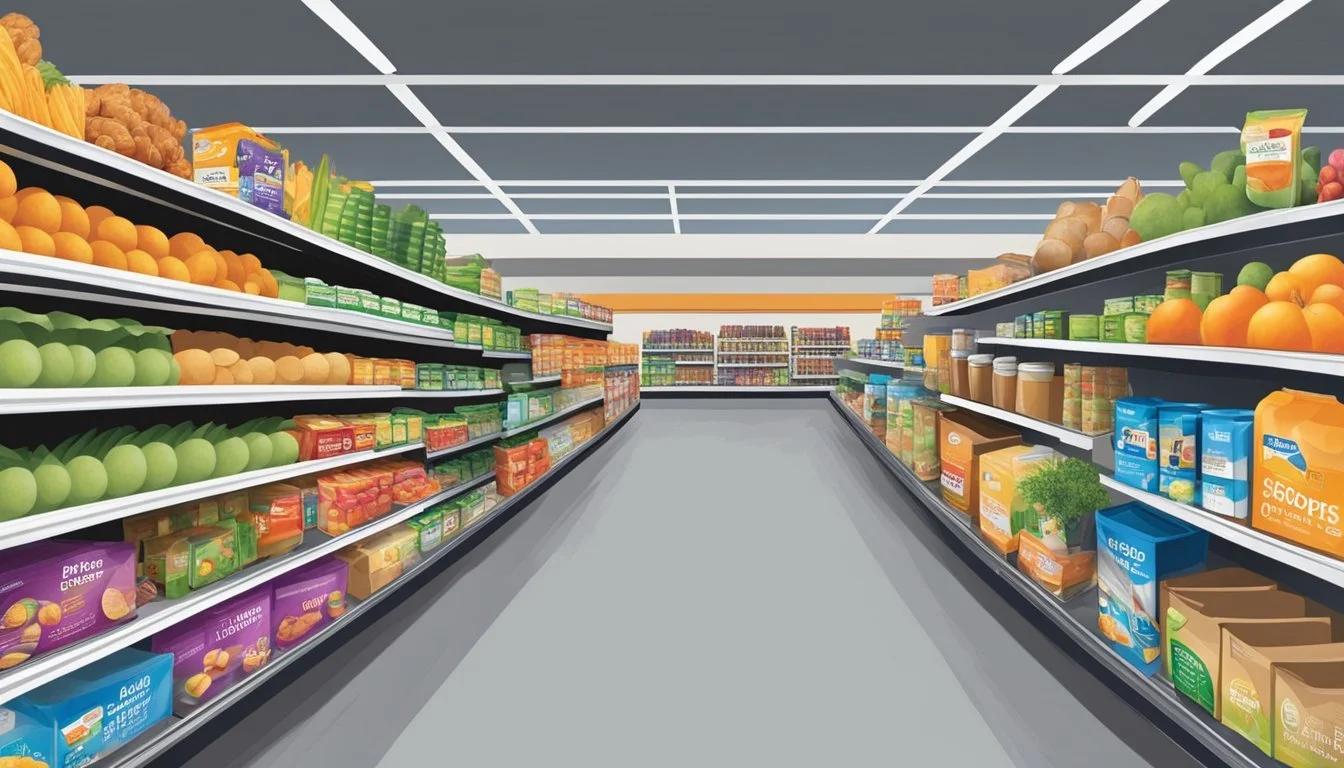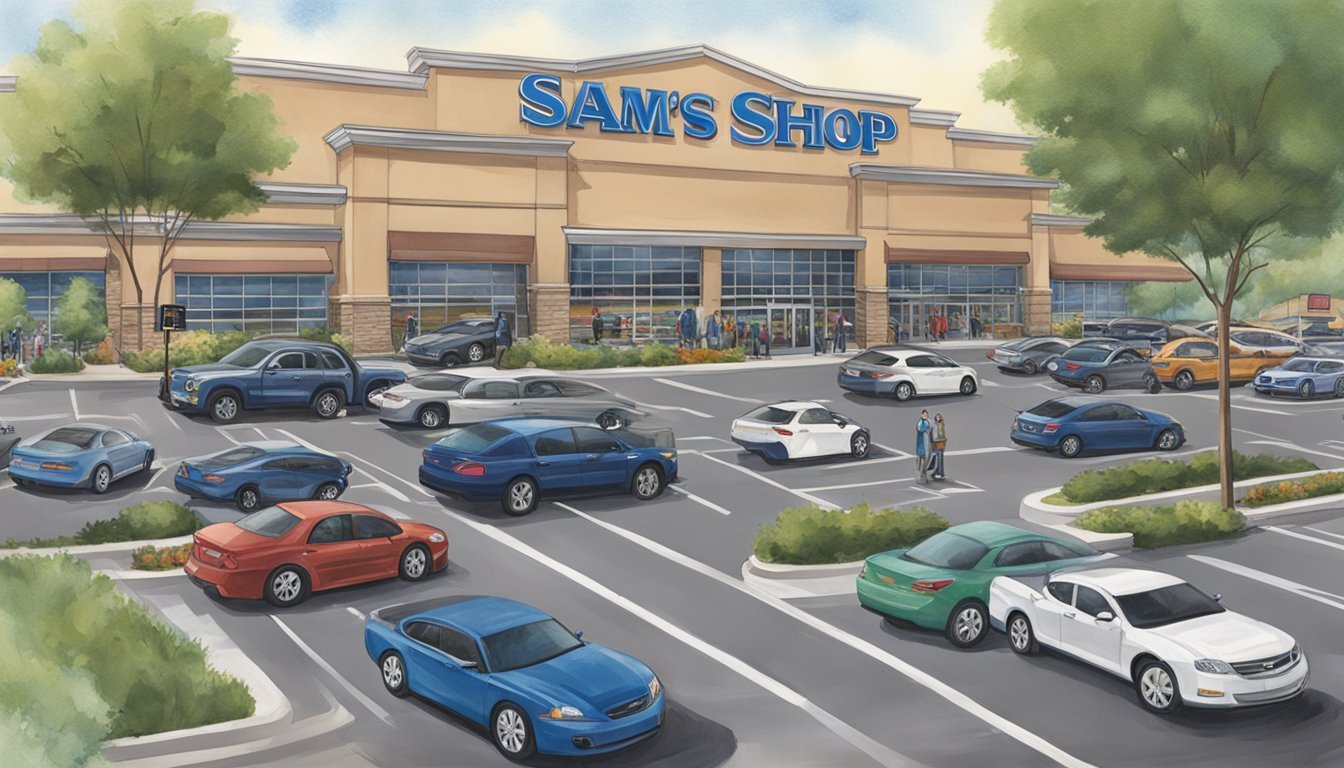Sam's Club vs Stop & Shop
Comparing Grocery Store Experiences
Part of Our Grocery Store Guide with Details on Sam's Club and Stop & Shop
Choosing the right grocery store can be a critical decision for many consumers, weighing factors like product variety, pricing, membership benefits, and overall shopping experience. Sam's Club, with its heritage tied to the retail giant Walmart, has established itself as a value-focused warehouse club, offering a range of bulk goods and merchandise at competitive prices. Known for its membership model, shoppers at Sam’s Club can expect to find a plethora of items from groceries to electronics, often in larger quantities geared towards savings over time.
Stop & Shop, on the other hand, operates on a more traditional supermarket model, providing a convenient and curated shopping experience with a variety of brands and products. Here, customers can shop for their daily needs without paying a membership fee, and they often have access to a more extensive selection of fresh produce, meats, and local products. Each store has its own unique perks and downfalls, making the comparison between Sam's Club and Stop & Shop a reflection of individual shopping preferences and priorities.
Company Overviews
In the competitive landscape of grocery retail, consumers often deliberate between the comprehensive warehouse models like Sam's Club and the traditional store layouts exemplified by Stop & Shop. Analyzing each company's history provides context into their operations and offerings.
History of Sam's Club
Sam's Club, a division of Walmart Inc., entered the market in 1983, founded by Sam Walton in Midwest City, Oklahoma. It operates on a membership-based model and, as of the information available, it has nearly 600 locations in the U.S. and Puerto Rico. Sam's Club is known for its bulk products and has been recognized for offering value to its customers partly due to Walmart's extensive buying power.
History of Stop & Shop
Originally a small grocery store that opened in 1892, Stop & Shop has evolved into a supermarket chain with over 400 stores across the Northeastern United States. It's now a part of Ahold Delhaize, an international food retail group. Stop & Shop focuses on providing a variety of groceries and everyday items, catering to consumers seeking a traditional supermarket experience.
Membership Comparison
When evaluating the membership options between Sam's Club and Stop & Shop, customers should consider the types of memberships offered, associated fees and benefits, and the available rewards and discounts.
Types of Memberships Offered
Sam's Club offers two primary types of memberships: the standard Club membership and the Plus membership. In contrast, Stop & Shop does not require a membership for shopping; however, it does offer a loyalty program known as Stop & Shop Go Rewards.
Sam's Club:
Club Membership: Basic membership option.
Plus Membership: Premium tier with additional benefits.
Stop & Shop:
No membership fees required.
Go Rewards: Loyalty program available to all customers.
Membership Fees and Benefits
Membership fees vary significantly between Sam's Club and Stop & Shop due to their differing models. Sam's Club charges an annual fee, while Stop & Shop offers free access to its rewards program.
Sam's Club:
Club Membership: Approximately $50 annually.
Plus Membership: Higher fee but includes more benefits such as free shipping, early shopping hours, and prescription discounts.
Stop & Shop:
Go Rewards: No fee, with benefits such as personalized offers and gas points.
Membership Rewards and Discounts
Both retailers offer unique rewards and discounts to their customers. Sam's Club provides cashback opportunities and exclusive offers for its member tiers, while Stop & Shop's Go Rewards program focuses on savings related to points accumulated through purchases.
Sam's Club:
Club Membership: Offers limited discounts and savings opportunities.
Plus Membership: Enhanced cashback options, including up to $500 per year in rewards with the Sam's Club Mastercard and up to 5% back at gas stations.
Stop & Shop:
Go Rewards: Users earn points on purchases that can be redeemed for grocery discounts or savings on gas.
Store Products and Services
When comparing Sam's Club and Stop & Shop, understanding the differences in product offerings and in-store services offered by each is essential for consumers.
Product Selection and Variety
Sam's Club is known for a wide range of bulk items, including food and home goods, catering to large families and businesses. Consumers can find a significant variety of products, from electronics to furniture, alongside a generous selection of food items. Stop & Shop, on the other hand, offers a focused product selection suited to everyday shoppers, with numerous brand-name foods, organic options, as well as flowers and pharmacy services. The stores prioritize quality and variety, ensuring shoppers can complete their shopping lists in one visit.
Exclusive Brands Comparison
Both retailers offer their own exclusive brands, with Sam's Club's Member's Mark brand providing products ranging from frozen fish to rotisserie chickens. These items frequently match or surpass comparable national brands in both price and quality. Conversely, Stop & Shop features its own brand equivalent which competes with well-known label products across various categories including food and household essentials.
In-Store Services
Sam's Club distinguishes itself with a range of in-store services such as a tire and battery center, pharmacy services, and optical center, enhancing the shopping experience beyond just product purchases. Stop & Shop also offers a pharmacy, along with a bank and a gas station in selected locations. Both stores are fully equipped to serve their customers' diverse needs, but Sam's Club offers certain bulk-centric services like business and tax preparation services and various business-to-business (B2B) solutions.
Pricing and Value
When comparing Sam's Club and Stop & Shop, pricing and value are two of the most critical factors that consumers consider. This section evaluates the cost-effectiveness of both retailers by investigating the price of common items as well as the benefits and drawbacks of bulk buying versus unit pricing.
Price Comparison of Common Items
The goal is to determine which store offers the better value for everyday groceries. Let's consider the pricing for a selection of staple items:
Eggs: Sam's Club offers eggs at discounted prices, often in larger quantities that result in a lower cost per egg.
Bananas: At Stop & Shop, bananas might be priced higher per unit, but shoppers can buy the exact quantity they need.
Pasta: Sam's Club's bulk options for pasta typically present more savings compared to purchasing smaller quantities at Stop & Shop.
Chicken Breast: Buying larger packs of chicken breast at Sam's Club could lead to better per-unit pricing.
Milk & Bread: Known for competitive pricing on dairy and bakery items, Sam's Club often undercuts Stop & Shop on milk and bread prices.
Peanut Butter & Cereal: Bulk sizes for pantry staples like peanut butter and cereal can be more economically purchased at Sam's Club.
Diapers: Sam's Club, with its affiliation to Walmart, offers substantial savings for bulk purchases compared to Stop & Shop.
Unit Pricing and Bulk Buying
Unit pricing is a key consideration when determining value. Sam's Club, which is known for its bulk buying model, can result in significant savings when compared to the unit prices at Stop & Shop. However, this assumes the customer has the need and storage capacity for larger quantities.
Bulk Buying: At Sam's Club, the cost per unit is typically lower when buying in bulk. This is ideal for non-perishable items or for households with higher consumption rates.
Discounted Prices: The affiliation between Sam's Club and its parent company, Walmart, provides the former access to Walmart's substantial buying power, allowing it to offer discounted prices on a wide array of products.
It is essential for consumers to assess their household needs and consumption patterns to determine whether lower unit prices through bulk buying from Sam's Club provide better value over Stop & Shop's more traditional retail model.
Shopping Experience
The shopping experience is often a critical aspect when comparing grocery stores. Key factors include store layout and design, customer service satisfaction, as well as checkout and payment options, which can significantly influence a shopper’s decision to choose Sam's Club or Stop & Shop.
Store Layout and Design
Sam's Club offers a warehouse-style layout with bulk merchandise and pallets accessible throughout the store. The layout is designed for efficiency, catering to shoppers who prefer buying in larger quantities. Shelves are typically higher and aisles broader to accommodate the size of products being sold.
Stop & Shop features a more traditional grocery store design. Aisles are arranged methodically, often with attention to creating a more appealing, navigable shopping experience. The layout usually provides for a quicker trip for customers seeking everyday items rather than bulk purchases.
Customer Service and Satisfaction
Sam's Club: Members often report a high level of satisfaction due to the store's exclusive membership model, which can lead to a sense of community and customer loyalty. Additionally, Sam's Club offers perks like instant savings on products as a part of their membership benefits.
Stop & Shop: It caters to a broader customer base and focuses on a more personalized shopping experience. They commonly employ customer service desks for direct assistance and frequently offer promotional deals tailored to individual shopping preferences.
Checkout and Payment Options
Sam's Club innovates with technology such as the Scan & Go feature, which allows customers to scan items with their mobile devices and bypass traditional checkout lines. They provide various payment options including credit cards, cash, and digital wallets, offering flexibility and convenience for their members.
Stop & Shop has responded to the need for convenience with self-checkout stations, alongside the standard cashier-manned registers. They also accept a wide array of payment options and participate in cash-back programs, enhancing the customer's shopping experience and satisfaction.
Additional Services and Benefits
When comparing Sam's Club and Stop & Shop, one should consider not just the products offered, but the range of additional services and benefits that enhance the shopping experience. Both retailers provide unique advantages in terms of fuel services, travel and insurance deals, and online and mobile shopping capabilities.
Fuel Services
Sam's Club provides discounted gas to its members at select locations, often resulting in significant savings. Members can find location-specific gas prices directly through the Sam's Club app, with discounted gas being a key advantage for those with a longer commute or who travel regularly. Stop & Shop, on the other hand, offers a Gas Rewards program where shoppers can earn points on purchases to save on fuel at Stop & Shop gas stations or participating Shell stations.
Travel and Insurance
While Sam's Club extends their offerings beyond the retail space with options for members to book travel and purchase insurance at competitive rates, their focus on bulk savings translates into the travel sector, with members benefitting from discounts on rental cars, hotels, and vacation packages. Stop & Shop does not typically specialize in travel and insurance services, focusing more on the traditional grocery store model.
Online and Mobile Shopping
Both retailers have embraced the digital age with online shopping platforms. Sam's Club has invested in their app and website, providing a seamless online and mobile shopping experience, complete with curbside pickup and free shipping for Plus members on eligible items. Stop & Shop also offers an app that features online shopping, with curbside pickup available, making grocery shopping more convenient for their customers. However, Stop & Shop does not typically offer free shipping, as their focus is more on in-store and curbside services.
Consumer Considerations
When evaluating which grocery store is better, consumers weigh a variety of factors such as their budget, health needs, and the environmental impact of their purchases. These considerations often influence a shopper's decision to choose between Sam's Club and Stop & Shop.
Personal Finance and Budgeting
Sam's Club requires an annual membership fee, which may be a consideration for individuals prioritizing personal finance and inflation. The basic membership costs $50 per year. In terms of budgeting, Sam's Club may offer savings on bulk items that could cater to families looking to stretch their income further. Shoppers often find that per-unit costs of goods can be lower at warehouse clubs like Sam's Club, which can be beneficial during times of high inflation.
Membership Costs: Sam's Club - $50/year for the basic Club membership
Bulk Savings: Higher upfront cost, potential long-term savings
Stop & Shop does not require a membership, allowing shoppers to purchase items without that initial cost. They offer weekly deals and a points-based rewards system that can help with budgeting grocery expenses.
No Membership Required: Pay for groceries without annual fees
Rewards System: Save money using points and weekly specials
Health and Dietary Options
Shopping for healthy and dietary-specific products is another critical consumer consideration. Stop & Shop features a range of organic and health-conscious options, catering to those with specific dietary needs or preferences for organic produce. They label these healthful items clearly, aiding customers in making informed choices.
Healthful Choices: Clearly labeled organic and dietary-specific products
Sam's Club might offer fewer organic options compared to Stop & Shop, but the wholesale pricing model can make it more affordable for families to purchase larger quantities of health-oriented goods at reduced prices.
Organic Availability: Limited, typically at a lower cost in bulk quantities
Environmental and Sustainability Practices
Consumers increasingly consider the environmental and sustainability practices of the stores they patronize. Stop & Shop has initiatives that focus on reducing waste and promoting sustainable seafood, directly responding to ecological concerns.
Waste Reduction: Initiatives to reduce waste in packaging and products
Sustainable Seafood: Commitment to selling sustainably sourced seafood
While Sam's Club has made strides in sustainability by offering eco-friendly products and incorporating energy-saving practices in their operations, they may not disclose these efforts as prominently as Stop & Shop.
Eco-friendly Products: Available selection for environmentally conscious shoppers
Operational Sustainability: Energy-saving practices in place
Location and Accessibility
When comparing Sam's Club and Stop & Shop in terms of location and accessibility, Sam's Club has a robust presence with close to 600 locations dotted across the United States and Puerto Rico. The warehouse chain is affiliated with Walmart, its parent company, which is renowned for its extensive network of retail stores. This link with Walmart can be a crucial factor in Sam's Club's geographical reach and convenience for customers looking for accessible shopping options.
In contrast, Stop & Shop operates more than 400 stores, but its presence is concentrated in the Northeast. For shoppers residing in this region, Stop & Shop provides a familiar and easily reachable destination for groceries.
Below is a quick comparison of the store locations:
Chain Locations Regional Coverage Affiliated with Sam's Club ~600 Across U.S. and Puerto Rico Walmart Stop & Shop >400 Concentrated in the Northeast None noted
For customers in areas like Texas, which has a considerable number of Walmart and Sam's Club stores, accessibility to Sam's Club would likely be greater when compared to Stop & Shop. Shoppers seeking alternatives to other grocery chains such as Target, Aldi, or Publix might find Sam's Club particularly accessible owing to Walmart's extensive supply chain and influence.
Customers need to consider the distribution of store locations and whether proximity to a Walmart indicates the presence of a Sam's Club nearby, which, for many, may enhance the ease of access to the grocery shopping experience that Sam's Club offers.
Consumer Reviews and Research
Consumer reviews illustrate preferences and satisfaction levels which can vary between Sam's Club and Stop & Shop. Research into the two retailers often focuses on pricing, product quality, and the shopping experience.
Sam's Club:
Pricing: Known for bulk purchases and membership-based savings.
Product Quality: They offer a wide range of merchandise, including groceries and electronics.
Shopping Experience: Large warehouse settings; membership required for shopping.
Stop & Shop:
Pricing: Regular promotions and deals; a more traditional pricing structure.
Product Quality: They provide a variety of organic and conventional products.
Shopping Experience: Smaller, more conventional supermarket layout; no membership needed.
Consumer Satisfaction:
Sam's Club: Scored well for bulk purchase savings.
Stop & Shop: High marks for customer service and local convenience.
Comparison:
Research typically compares the two based on the volume of sales, the diversity of products, and overall customer satisfaction.
Aspect Sam's Club Stop & Shop Pricing Lower per unit in bulk Competitive regular pricing Product Quality Good for both bulk and individual High-quality options Shopping Exp. Warehouse, membership-only Traditional, easy access Satisfaction High for bulk shoppers Preferred for local shopping
Researchers often conduct studies based on a wide array of metrics, which might include market share, customer loyalty, and repeat purchases to determine which store maintains a competitive edge.
Final Thoughts
When deciding between Sam's Club and Stop & Shop, shoppers often consider several factors including the variety of groceries, quality of produce and meats, cost savings, and the overall shopping experience.
Sam's Club's advantages primarily hinge on its bulk purchasing format, which typically delivers cost savings on a wide array of products. The wholesale model of Sam's Club can be particularly beneficial for those shopping for large households or business needs. They tend to offer significant discounts on a shopper's grocery list, especially when buying in larger quantities.
Savings: Sam's Club might offer better savings on bulk items.
Meat & Produce Quality: Quality can vary by location, but Stop & Shop generally provides a broad selection of fresh produce and meats.
Groceries: Stop & Shop caters to more conventional shopping habits and may have a wider variety of brands.
Stop & Shop, in contrast, caters to a different shopping pattern, one that doesn't necessarily require large quantity purchases and often presents a more traditional grocer experience. They offer a diverse range of products, and their quality, particularly in meat and produce, is generally well-regarded.
Both stores have their merits and cater to different consumer needs. Therefore, shoppers must assess their individual preferences, consumption rates, and the importance they place on savings versus variety and product brands. The decision may also come down to proximity and the convenience of the shopping experience provided by each store.












